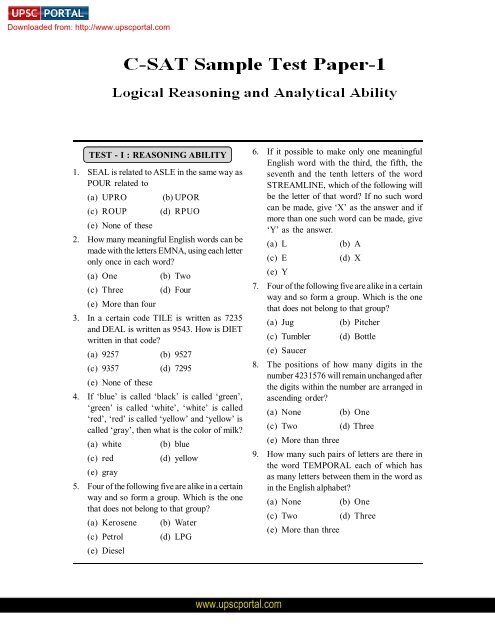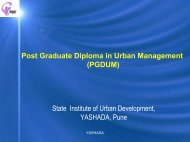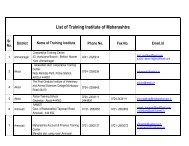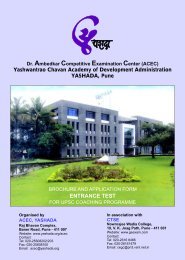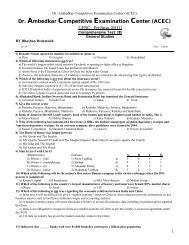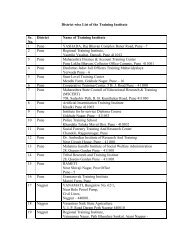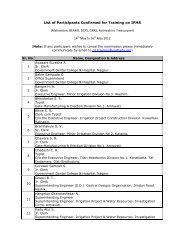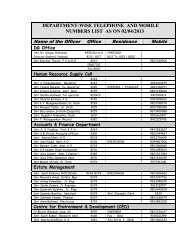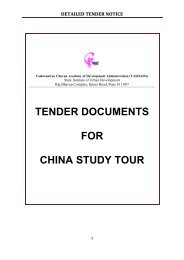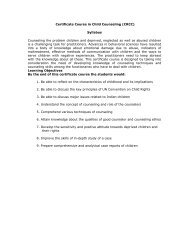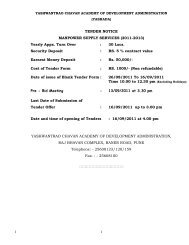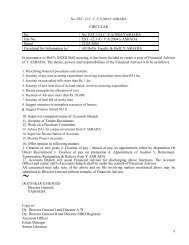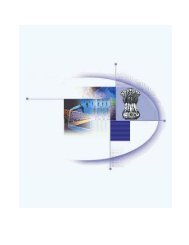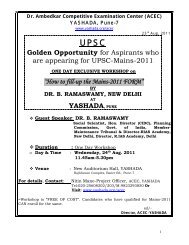CSAT Logical Reasoning Paper-I - yashada
CSAT Logical Reasoning Paper-I - yashada
CSAT Logical Reasoning Paper-I - yashada
You also want an ePaper? Increase the reach of your titles
YUMPU automatically turns print PDFs into web optimized ePapers that Google loves.
Downloaded from: http://www.upscportal.com<br />
TEST - I : REASONING ABILITY<br />
1. SEAL is related to ASLE in the same way as<br />
POUR related to<br />
(a) UPRO (b)UPOR<br />
(c) ROUP<br />
(e) None of these<br />
(d) RPUO<br />
2. How many meaningful English words can be<br />
made with the letters EMNA, using each letter<br />
only once in each word<br />
(a) One<br />
(c) Three<br />
(e) More than four<br />
(b) Two<br />
(d) Four<br />
3. In a certain code TILE is written as 7235<br />
and DEAL is written as 9543. How is DIET<br />
written in that code<br />
(a) 9257 (b) 9527<br />
(c) 9357 (d) 7295<br />
(e) None of these<br />
4. If ‘blue’ is called ‘black’ is called ‘green’,<br />
‘green’ is called ‘white’, ‘white’ is called<br />
‘red’, ‘red’ is called ‘yellow’ and ‘yellow’ is<br />
called ‘gray’, then what is the color of milk<br />
(a) white<br />
(c) red<br />
(e) gray<br />
(b) blue<br />
(d) yellow<br />
5. Four of the following five are alike in a certain<br />
way and so form a group. Which is the one<br />
that does not belong to that group<br />
(a) Kerosene<br />
(c) Petrol<br />
(e) Diesel<br />
(b) Water<br />
(d) LPG<br />
6. If it possible to make only one meaningful<br />
English word with the third, the fifth, the<br />
seventh and the tenth letters of the word<br />
STREAMLINE, which of the following will<br />
be the letter of that word If no such word<br />
can be made, give ‘X’ as the answer and if<br />
more than one such word can be made, give<br />
‘Y’ as the answer.<br />
(a) L<br />
(c) E<br />
(e) Y<br />
(b) A<br />
(d) X<br />
7. Four of the following five are alike in a certain<br />
way and so form a group. Which is the one<br />
that does not belong to that group<br />
(a) Jug<br />
(c) Tumbler<br />
(e) Saucer<br />
(b) Pitcher<br />
(d) Bottle<br />
8. The positions of how many digits in the<br />
number 4231576 will remain unchanged after<br />
the digits within the number are arranged in<br />
ascending order<br />
(a) None<br />
(c) Two<br />
(e) More than three<br />
(b) One<br />
(d) Three<br />
9. How many such pairs of letters are there in<br />
the word TEMPORAL each of which has<br />
as many letters between them in the word as<br />
in the English alphabet<br />
(a) None<br />
(c) Two<br />
(e) More than three<br />
(b) One<br />
(d) Three<br />
www.upscportal.com
Downloaded from: http://www.upscportal.com<br />
C-SAT Sample Test <strong>Paper</strong>-1<br />
10. In a certain code ORIENTAL is written as<br />
DHQNMBUO. How is SCHOOLED written<br />
in that code<br />
(a) RBGNPMFE<br />
(c) RBGNEFMP<br />
(e) None of these<br />
(b) NGBREFMP<br />
(d) NGBRPMFE<br />
11. Four of the following five are alike in a certain<br />
way and so form a group. Which is the one<br />
that does not belong to that group<br />
(a) 35 (b) 28<br />
(c) 56 (d) 42<br />
(e) 49<br />
12. In a certain code language ‘Ja na da’ means<br />
‘what you want’, ‘na pa ka’ means ‘they want<br />
food’, and ‘ka ho ni’ means ‘food and water’.<br />
What does ‘da’ mean in that code language<br />
(a) what<br />
(c) what or you<br />
(e) None of these<br />
(b) you<br />
(d) Data inadequate<br />
13. The positions of the first and the sixth digits<br />
in number 8312075649 are interchanged.<br />
Similarly, the positions of the second and the<br />
seventh digits are interchanged, and so on.<br />
Which of the following will be the sixth digit<br />
from the right end after the rearrangement<br />
(a) 7 (b) 9<br />
(c) 0 (d) 2<br />
(e) None of these<br />
14. ‘MQ’ is related to ‘PU’ and ‘FI’ is related<br />
to ‘IM’ in the same way as ‘SV’ is related to<br />
(a) VY<br />
(c) TX<br />
(e) None of these<br />
(b) UY<br />
(d) VZ<br />
15. Four of the following five are alike in a certain<br />
way and so form a group. Which is the one<br />
that does not belong to that group<br />
(a) Cabbage<br />
(b) Brinjal<br />
(c) Sweet Gourd<br />
(e) Bitter Gourd<br />
(d) Pumpkin<br />
Direction (Q. 16-21) : In each of the questions<br />
below are given four statements following by two<br />
conclusions numbered I and II. You have to take<br />
the given statements known facts. Read all the<br />
conclusions and then decide which of the given<br />
conclusions logically follows from the given<br />
statements disregarding commonly known facts.<br />
Give answer (a) : if only Conclusion I follows.<br />
Give answer (b) : if only Conclusion II<br />
follows.<br />
Give answer (c) : if either Conclusion I or II<br />
follows.<br />
Give answer (d) : if neither Conclusion I or II<br />
follows.<br />
Give answer (e) : if both Conclusion I or II<br />
follows.<br />
16. Statements : Some pins are magnets.<br />
Some magnets are scales.<br />
Some scales are trucks.<br />
All trucks are buses.<br />
Conclusion : I. Some trucks are pins.<br />
II. No truck is pin.<br />
17. Statements : All jungles are trees.<br />
All trees are roads.<br />
All roads are houses.<br />
All houses are buildings.<br />
Conclusion : I. All trees are houses.<br />
II. Some buildings are<br />
roads.<br />
18. Statements : All tablets are packets.<br />
No packet is bag.<br />
Some bags are toys.<br />
All toys are puppets.<br />
Conclusion : I. Some puppets are<br />
tablets.<br />
www.upscportal.com
Downloaded from: http://www.upscportal.com<br />
C-SAT Sample Test <strong>Paper</strong>-1<br />
II. Some puppets are<br />
bags.<br />
19. Statements : Some desks are tables.<br />
Some tables are chairs.<br />
Some chairs are benches.<br />
Some benches are cots.<br />
Conclusion : I. Some chairs are desks.<br />
II. Some cots are tables.<br />
20. Statements : All bangles are rings.<br />
All rings are bracelets<br />
Some bracelets are jewels.<br />
Some jewels are stones.<br />
Conclusion : I. Some stones are<br />
bangles.<br />
II. Some jewels are rings.<br />
21. Statements : All trousers are pants.<br />
Some pants are shirts.<br />
All shirts are buttons.<br />
Some buttons are threads.<br />
Conclusion : I. Some threads are<br />
pants.<br />
II. Some buttons are<br />
trousers.<br />
Direction (Q. 22-28) : Study the following<br />
arrangement carefully and answer the questions<br />
given below :<br />
M%TAP4« ED17NIJ5$3FH8UB6@<br />
WL2©KQ#<br />
22. How many such symbols are there in the<br />
above arrangement, each of which is<br />
immediately preceded by a consonant but not<br />
immediately following by a number<br />
(a) None<br />
(c) Two<br />
(e) More than Three<br />
(b) One<br />
(d) Three<br />
23. Group of the following five are alike in a<br />
certain way based on their positions in the<br />
above arrangement and so form a group.<br />
Which is the one that does not belong to that<br />
group<br />
(a) DNE<br />
(c) WC@<br />
(e) 5FJ<br />
(b) HBF<br />
(d) AMP<br />
24. Which of the following is the ninth to the right<br />
of the twentieth from the right of the above<br />
arrangement<br />
(a) T (b) 8<br />
(c) U<br />
(e) None of these<br />
(d) n<br />
25. If the last twelve elements are the above to<br />
arrangement are written in the reverse order,<br />
which of the following will be the twentyfourth<br />
from the left end<br />
(a) L<br />
(c) C<br />
(e) None of these<br />
(b) W<br />
(d) K<br />
26. How many such consonants are there in the<br />
above arrangement, each of which is<br />
immediately preceded by a number and<br />
immediately followed by a number and<br />
immediately followed by a symbol<br />
(a) None<br />
(c) Two<br />
(e) More than three<br />
(b) One<br />
(d) Three<br />
27. If all the symbols in the above arrangement<br />
are dropped, which of the following will be<br />
the fifteenth from the left end<br />
(a) 3<br />
(c) 8<br />
(e) None of these<br />
(b) H<br />
(d) F<br />
28. How many such numbers are there in the<br />
above arrangement, each of which<br />
immediately followed by a vowel but not<br />
www.upscportal.com
Downloaded from: http://www.upscportal.com<br />
C-SAT Sample Test <strong>Paper</strong>-1<br />
immediately preceded by a consonant<br />
(a) None<br />
(c) Two<br />
(e) More than three<br />
(b) One<br />
(d) Three<br />
Direction (Q. 29-33) : In the following questions,<br />
the symbols ,o, #, © and @ are used<br />
with the following meaning as illustrated below :<br />
‘P Q’ means ‘P is not greater than Q’.<br />
‘PoQ’ means ‘P is neither greater than nor equal<br />
to Q’.<br />
‘P # Q’ means ‘P is not smaller than Q’.<br />
‘P©Q’ means ‘P is neither smaller than nor<br />
greater to Q’.<br />
‘P@Q’ means ‘P is neither smaller than nor equal<br />
to Q’.<br />
Now in each of the following questions<br />
assuming the given statements to be true, fine<br />
which of the two conclusions I and II given below<br />
them is/are definitely true<br />
Give answer (a) : if only Conclusion I is true.<br />
Give answer (b) : if only Conclusion II is true.<br />
Give answer (c) : if either Conclusion I or II<br />
is true.<br />
Give answer (d) : if neither Conclusion I nor<br />
II is true.<br />
Give answer (e) : if both Conclusion I or II<br />
are true.<br />
29. Statement : B N, NoK, K©D<br />
Conclusion I. D@B II. B K<br />
30. Statement : F@R, R W, W#D<br />
Conclusion I. Do R II. F@W<br />
31. Statement : T V, V@N, NoJ<br />
Conclusion I. J@R II. J V<br />
32. Statement : M©T, T@R, R#J<br />
Conclusion I. JoT II. RoM<br />
33. Statement : K©B, BoM, M@R<br />
Conclusion I. RoK II. M@K<br />
Direction (Q. 34-40) : Study the following<br />
information carefully and answer the questions<br />
given below :<br />
Following are the conditions for selecting<br />
Personnel officer in an organization:<br />
The candidate must<br />
(i) be a graduate with a least 55 per cent marks,<br />
(ii) be a postgraduate degree/diploma holder in<br />
management with Personnel/HRD<br />
specialisation with at least 60 per cent marks,<br />
(iii) have secured at least 60 per cent marks in<br />
the selection process,<br />
(iv) be at least 25 years and not more than 30<br />
years old as on 01.06.2007.<br />
In the case of a candidate who satisfies all<br />
the above conditions EXCEPT<br />
(A) at (iii) above, but has secured at least 65 per<br />
cent in postgraduate degree/diploma, the case<br />
is to be referred to DGM- Personnel.<br />
(B) at (ii) above, but has been working for at<br />
least three years in personnel department of<br />
an organisation, the case is to be referred to<br />
GM-Personnel.<br />
In each question below, details of one<br />
candidate is given have to take one of the following<br />
courses of action for each candidate based on<br />
the information provided and the conditions and<br />
sub-conditions given above and mark the number<br />
of that course of action as your answer. You are<br />
not to assume anything other than the information<br />
provided in each question. All these than cases<br />
are given to you as on 01.07.2007.<br />
Mark answer (a): if the candidate is to be<br />
selected.<br />
Mark answer (b): if the data provided are not<br />
www.upscportal.com
Downloaded from: http://www.upscportal.com<br />
C-SAT Sample Test <strong>Paper</strong>-1<br />
adequate to take a decision.<br />
Mark answer (c): if the candidate is not be<br />
selected.<br />
Mark answer (d): if the case is to referred to<br />
be DGM-Personnel.<br />
Mark answer (e): if the candidate is to be<br />
referred to GM-Personnel.<br />
34. Sohan Das has secured 62 per cent marks in<br />
graduation and 58 per cent marks in the<br />
selection process. He was born on 8 th October<br />
1978. He has also secured 68 per cent marks<br />
in postgraduate diploma in Management with<br />
Personnel specialisation.<br />
35. Nikhil Goel was born on 8 th July 1980. He<br />
has been working in the personnel department<br />
of an organization for the past four years.<br />
He has secured 60 per cent marks in<br />
graduate and 65 per cent marks in the<br />
selection process. He has recently enrolled<br />
in a postgraduate degree programme in<br />
Personnel Management.<br />
36. Sudha Kulkarni was born on 3 rd January 1980.<br />
She has secured 62 per cent marks in<br />
graduation. She has also secured 65 per cent<br />
marks in the selection process. She has<br />
completed postgraduate diploma in<br />
Management with HRD specialisation.<br />
37. Subodh Dhar has secured 62 per cent marks<br />
in the selection process and 65 per cent marks<br />
in graduation. He was born on 15 th April<br />
1979. He has also secured 58 per cent marks<br />
in postgraduate diploma in Personnel<br />
Management.<br />
38. Abhishek Varma has secured 65 per cent<br />
marks in graduation and 63 per cent marks in<br />
postgraduate degree in Management with<br />
HRD specialisation. He was born on 13 th<br />
May 1981. He has secured 58 per cent marks<br />
in the selection specialisation.<br />
39. Navin Ghosh was born on 4 th November<br />
1979. He has secured 57 per cent marks in<br />
the selection process and 62 per cent marks<br />
in graduation. He has also secured 67 per<br />
cent marks in postgraduate diploma in<br />
Management with Personnel specialisation.<br />
40. Neha Saklani was born on 24 th September<br />
1981. She has secured 65 per cent marks in<br />
both graduation and selection process. She<br />
has also secured 63 per cent graduate diploma<br />
in Management with HRD specialisation.<br />
Direction (Q. 41-45) : Study the following<br />
information carefully and answer the questions<br />
given below :<br />
A, B, C, D, E, F, G and H are sitting around a<br />
circle facing the centre. D is second to the left of<br />
H, who is third to left of A, B is fourth to the right<br />
of C, who is the immediate neighbour of H. G is<br />
not a neighbour of B or C. F is not a neighbour of<br />
B.<br />
41. In which of the following pairs is the first<br />
person sitting to the immediate right of the<br />
second person<br />
(a) DG<br />
(c) HB<br />
(e) None of these<br />
(b) BE<br />
(d) GH<br />
42. Who is third to the left B<br />
(a) G<br />
(c) C<br />
(e) None of these<br />
(b) B<br />
(d) Data inadequate<br />
43. What is F’s position with respect to G<br />
(a) Second towards left<br />
(b) Second towards right<br />
(c) Third towards left<br />
(d) Third towards right<br />
(e) None of these<br />
44. Who is sitting between A and B<br />
(a) E only<br />
(c) Both E and H<br />
(b) H only<br />
(d) Data inadequate<br />
www.upscportal.com
Downloaded from: http://www.upscportal.com<br />
C-SAT Sample Test <strong>Paper</strong>-1<br />
(e) None of these<br />
45. How many of them are sitting between C<br />
and B<br />
(a) Two only<br />
(b) Four only<br />
(c) Two or Four only<br />
(d) Three only<br />
(e) None of these<br />
Direction (Q. 46-50): Below in each question<br />
are given two statements ((A) and ((B). These<br />
Statements may be either independent causes or<br />
may be effects of independent causes or a<br />
common cause. One of these statements may be<br />
the effect of the other statement. Read both the<br />
statement and decide which of following answer<br />
choices correctly depicts the relationship between<br />
these two statements.<br />
Mark answer (a) : if statement (A) is<br />
the cause and statement (B)<br />
is its effect.<br />
Mark answer (b) : if statement (B) is<br />
the cause and statement (A)<br />
is its effect.<br />
Mark answer (c) : if both the<br />
statements (A) and (B) are<br />
independent causes.<br />
Mark answer (d) : if both the<br />
statements (A) and (B) are<br />
effects of independent<br />
causes.<br />
Mark answer (e) : if both the<br />
statements (A) and (B) are<br />
effects of some common<br />
cause.<br />
46. (A)The prices of cement have increased<br />
manifold during the past few years.<br />
(B) Goverment has decided to provide tax<br />
break for five years to the new cement<br />
manufacturing factories to be set up in<br />
near future.<br />
47. (A)Police resorted to lathi charge on the<br />
unruly mob gathered outside the police<br />
station to protest against the atrocities of<br />
corrupt police officials.<br />
(B) Government has initiated an enquiry into<br />
the alleged atrocities committed by some<br />
of the police officers.<br />
48. (A)This year majority of the X Std. students<br />
of the local school opted Sanskrit as the<br />
third language.<br />
(B) Last year majority of X Std. students of<br />
the local school opted French as the third<br />
language.<br />
49. (A)The prices of vegetable have increased<br />
substantially during the past few weeks.<br />
(B) Government had reduced the prices of<br />
petroleum products about a month back.<br />
50. (A)A large number of people rushed to the<br />
Super Bazar on Sunday.<br />
(B) The Super Bazar offered heaven<br />
discounts for a very large number of<br />
merchandise on Sunday.<br />
www.upscportal.com
Downloaded from: http://www.upscportal.com<br />
Answers<br />
1. a 2. d 3. a 4. c 5. b 6. e 7. e 8. d<br />
9. e 10. b 11. e 12. c 13. b 14. d 15. a 16. c<br />
17. e 18. b 19. d 20. d 21. d 22. c 23. d 24. c<br />
25. e 26. a 27. d 28. a 29. a 30. d 31. c 32. e<br />
33. b 34. a 35. c 36. e 37. d 38. a 39. a 40. b<br />
41. b 42. e 43. d 44. a 45. d 46. a 47. e 48. d<br />
49. d 50. b<br />
www.upscportal.com


